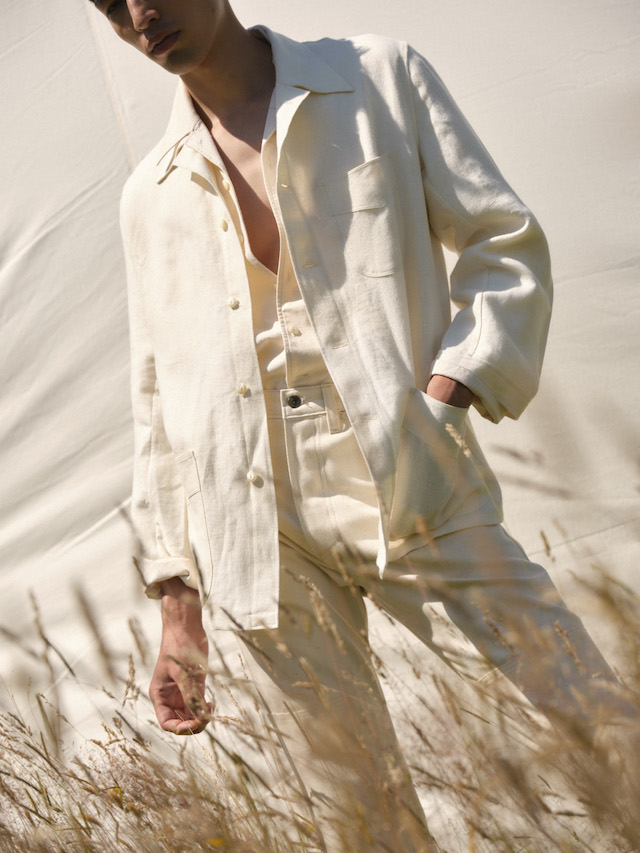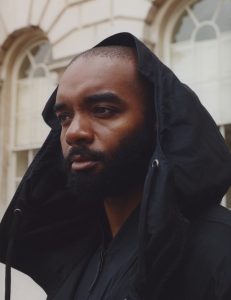In celebration of its month-long London residency, Luke Walker reflects on his menswear label and the joy of savvy construction

Before Luke Walker’s father became a primary school teacher, he worked in Rolls-Royce’s aeronautical division. His sketches of jet engines were meticulously hand drawn with pencil, ruler, set square and compass, and now, hang in Piccadilly Arcade. They are pride of place in L.E.J’s SS00022 London residency, the menswear label started by Walker in 2020 and which is now enjoying a month-long boutique space in London’s St. James’s. Their attention to detail, their craft and care, speak to the clothes that Walker creates. Inspired by the clean, functional lines of engineering, architecture, and vintage workwear and military detailing, L.E.J’s core offering of shirts – and everything else within its orbit – intends to bring the luxury fabrics and quality we associate with formal wear to the casual market.
In celebration of the residency, Port caught up with the wonderfully affable Walker to discuss the joy of savvy construction, protecting independent creativity, and the inherent practicality of workwear.

Why are your father’s sketches a source of creative inspiration?
I found these beautiful drawings in the shed 10 years ago and I was astonished by the pre-digital precision of them. That old draftsmanship quality of having to be so crisp and measured with your every stroke. It’s the love you can see in something which is inherently unromantic, but which is such an integral part of the process. The way that I design clothes is generally from the inside out. I think about the kind of seam construction I want to have, or the way in which I want the pleat to form and the stitching that needs to go into that, how the collar needs to sit, how that’s put together. So the way I design is quite engineer-like, in a sense.
As well as construction, you also start your designs with fabrics in mind?
Absolutely. I will always start by laying out a big selection from the mills, slightly chaotically, and then I’ll slowly refine. A certain fabric will speak to me about a specific garment and how it needs to be handled and treated. So if they’re a particular width, then I’ll develop a certain way for the garment to be cut so we use all of that. Or we can use it in a particularly clever way, for instance, some of the shirts which are cut from this beautiful Japanese Selvedge Oxford, the facings are turned in a way that is easy on the eye but they also act as a reinforcement. I’m always thinking about how the fabric can perform in the best possible way, and how we can use the inherent qualities of each to the fullest effect. When I send my factories a lot of my intended designs, they often tell me, ‘we can’t make this, this is impossible!’. But, we make it work, and both of us are all the better for learning new construction techniques.
When I look at all of my archives, the vintage and military pieces, they’re stitched in a certain way which is supposed to be functional and have a performance factor, whereas a lot of clothing these days is just put together for the ease of the production line. I just don’t think that’s the right way to do it. Going back to the way in which things used to be made, when economies of scale were less important, results in a more beautiful and characterful garment because it’s not the same as every other shop.

I understand you’ve got significant experience (over 15 years) designing and consulting for big global brands as well as smaller indie labels – how has all that know-how coalesced and helped create L.E.J?
I’m not doing something that’s super fashion, difficult to wear, or avant-garde with L.E.J. But what I do hope I’m doing is taking very staple menswear pieces, which most guys can wear, most aren’t going to be scared of, but injecting them with a little bit of that fashion heritage, the more flamboyant side of my career. For my first job I spent six years at Lanvin and that company, at that time, was the freest experience. It was like going to college and getting paid for it. You had to be experimental, inventive, and push the boundaries. It didn’t matter if menswear had certain rules, Alber (Elbaz) didn’t give two hoots about them, he actively encouraged us to rip them up. That schooling gave me the opportunity to ask questions about conventions, and that can be simple things at L.E.J, like using ties instead of buttons. Why not? It’s a bit tongue in cheek and that’s what I try to do with a lot of the pieces, not make them too serious. I’ve learned how important the creative aspect is, but I’ve also seen – when I’ve been inside bigger companies – that there’s often this cycle where the money men get a little bit scared and so the spreadsheets start to take charge, pieces get dumbed down. You start to dip your toe into the puddles of mediocrity, and why should you? The only reason for any brand to exist is independent creativity. Why be a copycat when you can really embrace what you’re doing? What your heart tells you to do? That, hopefully, will resonate with someone.

And, drawing on those years, what did you want to channel or do differently with L.E.J? I know stopping the depressing cycle of disposability of garments is important to you…
One of my main ambitions is to grow slowly and for it to be very organic. Not to let the money take over. I’ve been very reluctant to have any external pressure on that front. We all know what it’s like when, in any industry, investors get involved. They expect returns in exchange for their money, and often the returns that they want are very different to the returns that you, as the creative or the founder, want. I guess that’s a big thing that I’ve learned, that desire to not mushroom and be a flash in the pan. Because of my approach to construction, to fabrics, and the longevity that I’ve put into the clothes – I also want that to be in the brand. I don’t want it to be six great seasons and then we’re done.
Why the focus on shirting, and what else revolves around or compliments this?
After I left dunhill I was used to wearing super fine bespoke shirts, beautiful suits, but I couldn’t find the casual equivalent. That’s what the premise of the brand was, but like any hoarder or creative, I couldn’t resist doing the rest of it. When I was showing my shirt capsule to buyers, they said, ‘yeah, great, love it, can we have the rest?’. I guess they gave me the belief to grow it and for me to say: this my opinion for the total wardrobe. So it expanded very quickly from a handful of shirts into what it is today, a 25 look collection with almost everything a man needs.

Is there a garment you’re particularly proud of?
There’s two, which are kind of fraternal twins. I have a coat I call the Le Cat Posh Plage, which is a kind of over shirt made from slightly heavier fabrics like lightweight denim, and there is a version I call the quick release, a little chore coat with ribbons down the front that can be tied together. In the hot summer, I just wear it as lightweight layer, but then in winter I wear it tucked into pants and it’s got quite a nice Jacobean vibe.
That sounds right up my girlfriend’s street
I have a lot of female friends who are also customers and they look even better in the clothes than the men for which they are ostensibly designed. I love that. I use a lot of typically ‘feminine’ fabrics and don’t like to convey the brand in a very macho way. It’s more approachable, and I would like to develop that parity of customers.

Having launched the brand just a month after the UK lockdowns started, back in 2020, how has the pandemic inevitably shaped L.E.J?
A lot of brands over the last few years have had great success with sweats, but it’s not something I’m interested in. Selfishly, everything in the brand is what I want to wear and I don’t really go in for jersey or stretchy things. What I find comfortable and why I reference all of these workwear constructions is because they were invented – not just because a boxy silhouette looks good – but because back in the day I’d be swinging a sledgehammer for hours and need movement. So actually my 13 ounce, starchy Japanese chore jacket is comfortable because it’s not super tight, the movement is all engineered and pivoted in the right place. It’s what I work in every day.
Fashion has inevitably had to go offline these past few years, are you excited to have a physical residency in St James?
The short answer is yes. When I choose what I want to wear or buy, I need to touch the fabric and see the quality of the stitching with my own eyes. I want to connect with that garment because clothes are a second skin. I’m very lucky to have had great online partners – without them, I may not be here today – but I just can’t wait for people to come in and touch everything, see the beauty of the construction, to understand all of the little idiosyncrasies that I’ve put in and haven’t been able to communicate online. I want to put my resources in the physical world, build up trust with people.

What’s next?
From a business point of view, I’m not planning too much, so every move is quite ad hoc. I’m tending to go with what feels right, despite the industry standard to think 12 months ahead. That’s what the game is, but I like to leave some things up to happy accidents because that’s when you get real spontaneity. I’m hoping that the energy of the universe puts me in the right place.
L.E.J’s SS00022 residency runs until March 30th at 2, Piccadilly Arcade, London, SW1




